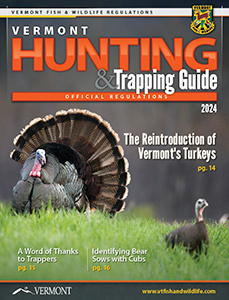Small Game Hunting
Gray squirrels are Vermont’s most overlooked small-game animal. “Bushytails” can be found wherever mature stands of oak, hickory and beech trees provide them with abundant nuts, especially in the southwestern portion of the state at lower elevations, the Champlain Valley, and along the Connecticut River. Although lightly hunted in Vermont, squirrels are a real challenge when stalked with a .22 rifle, and their delicate meat compares favorably with rabbit.
Cottontail rabbits are found primarily in the Southwestern Foothills and Champlain Valley, including the Champlain Islands. “Cottontails” favor the varied habitat found in agricultural lowlands and are commonly encountered in brushy hedgerows, overgrown fields, briar thickets, and shrub-filled creek bottoms. Kicking up cottontails on a crisp fall day is excellent sport, whether hunters elect to chase them with a beagle and shotgun or stalk them with a .22 rifle.
Snowshoe hare are found statewide but are most abundant in areas with active forest management, particularly in the Green Mountains and Northeast Kingdom. The greatest concentrations of hare are found in areas with dense, low-growing softwood, such as cedar swamps, spruce bogs and cut-over areas with thickets of young spruce and fir. Snowshoe hare have seasonally white coats and large hind feet, adaptations that let them remain active throughout the winter. They are a favorite of hunters with hounds because they prefer to run a hard race rather than hole-up, as cottontails often do when hard-pressed.
Seasons & Bag Limits
Species |
Season |
Bag Limit |
Gray Squirrel |
Sept. 1 – Dec. 31 |
4 daily; 8 possession |
Rabbit & Hare |
Sept. 30, 2023 – Mar. 10, 2024 & Sept. 28, 2024 – Mar. 9, 2025 WMUs D & E remain open through March 31 |
3 daily; 6 possession |
Sale of Small Game
It is illegal to buy or sell a wild bird, rabbit, hare or gray squirrel at any time.

